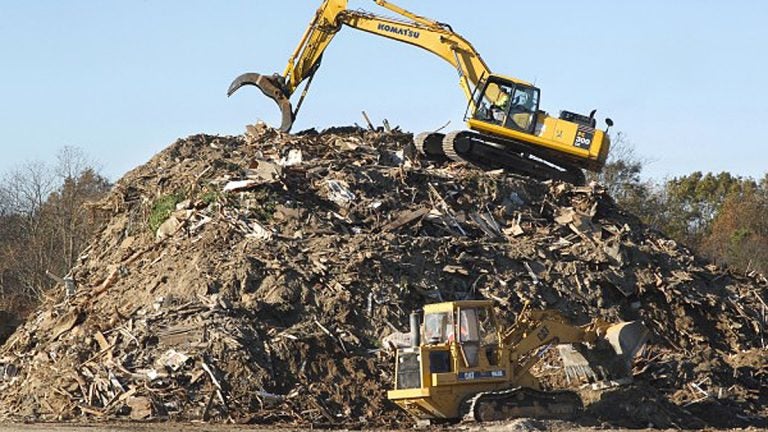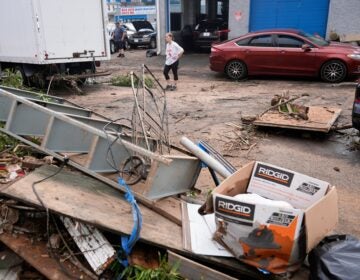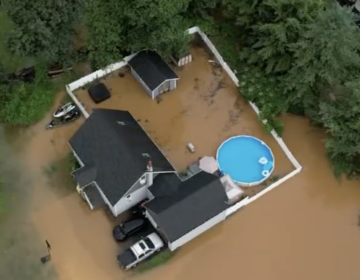Landfill neighbors fear Sandy-debris is making them sick

Heavy equipment operators work on a mountain of debris left by Superstorm Sandy. (Mel Evans/AP File Photo)
After Sandy slammed into New Jersey’s coast in October, 2012, the state was left with the gargantuan task of collecting and disposing of nearly nine million cubic yards of debris, enough to fill a football stadium almost a mile high, according to FEMA.
As soggy carpets and damaged appliances piled up on people’s curbs, landfills and incinerators around the state were granted special, emergency permits to operate longer hours and more days a week to process all the waste.
In addition to all the regular sites, the Fenimore landfill in Roxbury, N.J. was very likely the final destination of some of that trash, although state officials say there’s no evidence to link the massive increase in debris at the site to Sandy.
Since that time, people living near the landfill have gotten sick, the site has become entangled in a myriad of lawsuits, and some town residents feel they’ve indirectly become victims of the storm, even though they live nowhere near the Shore.
Environmentalists say Fenimore is an extreme example of what can happen when regulations aren’t strict enough. They say the landfill presents valuable lessons for how New Jersey should handle its waste, particularly in the aftermath of future disasters. They also criticize the state for not yet learning from its mistakes and are recommending a variety of changes to regulations.
For its part, the state says Fenimore was an isolated case that had “gone wrong” and points the finger at the landfill owner.
The Fenimore BackstoryFenimore operated as a private landfill from the 1950s to the late ’70s, accepting municipal waste from half a dozen towns in Morris County. The state shut it down in 1979, in part because it failed to meet newer environmental requirements to keep contaminants from spreading off the property.
Over the next several decades, ownership of the site changed hands several times, but it remained unused. Trees and reed grasses began to regrow on the landfill, and residential neighborhoods sprang up around the perimeter. While noting some problems, a study commissioned by the NJDEP in 2005 basically gave Fenimore a clean bill of health.
“Based on the results of the analyses of the portable well, soil, surface water, sediment, leachate, and soil gas samples collected, no conditions were found to exist at the site that pose an acute, immediate direct threat to human health. Accordingly, this site does not pose an Immediate Environmental Concern as defined by NJDEP,” the report said. Like many older landfills, Fenimore was never properly closed, though. In accordance with state requirements, closing a landfill entails covering it with a thick, Polyethylene-like liner or a layer of clay densely packed several feet thick to “minimize long term infiltration and percolation of liquid.” Gravel, cement or demolition material is sometimes mixed in to stabilize the cap, and then it’s covered with topsoil and planted with vegetation to keep it from eroding.
Fenimore is hardly unique. According to a state database, out of 814 known or suspected landfills in New Jersey that are no longer in operation, just 88 have been properly closed, while 725 – or nearly 90 percent — were never correctly capped. The state has a sanitary landfill closure fund — supported by taxes imposed on landfill operators — that’s supposed to help cover the costs of properly closing some of these older landfills, but lawmakers have routinely raided this fund, diverting more than $100 million to other uses over the past decade, said New Jersey Sierra Club director Jeff Tittel.
Relying on the Private SectorGiven the reality that it could cost billions of dollars to go back and close all these landfills, the state has increasingly turned to the private sector in recent years to pick up some of the slack. New Jersey’s most recent Energy Master Plan advocates turning landfills and brownfield sites into solar farms to help with their cleanup.
“Some of these properties cannot be developed for general commercial or residential purposes and may not provide adequate revenue to the towns and counties where they are situated,” the plan says. “However, solar development can offset the costs to cap and or remediate these sites and should be encouraged where local government has determined it to be the best use of the property.”
But while solar farms may sound like a great idea, they’re costly to build, and the return on investment could take years. In the meantime, site owners need funding to kick-start the process and prepare the land. That’s where things get complicated.
Environmentalists say the most ecologically sound method of capping a site to seal in contaminants, level it out, and provide a stable base for installation of solar panels is to simply add “clean fill” — soil that’s free of extraneous debris, solid waste or other contaminants.
“Under no circumstances does it make environmental or economic sense to bring in dirty fill, except perhaps to the landfill owner,” says Eric Goldstein, a senior attorney at the Natural Resources Defense Council. “It’s a major public risk, and I think you could find municipal landfill operators around the country who would say that that’s a real no-no.”
But what Goldstein proposes is much easier said than done, argues Matthew Fredericks, the attorney representing Strategic Environmental Partners (SEP), which now owns the Fenimore Landfill. SEP purchased the site in January, 2011 and signed an agreement with the Department of Environmental Protection in October of that year to close Fenimore and build a solar farm.
“If the state had all the money in the world, it would be easy. Just go around and put clean material that’s very expensive to obtain and clean these places up,” Fredericks said. “The state doesn’t have that money, and so you need an economic model that allows these sites to be capped.”
That economic model involves allowing landfill operators to accept truckloads of new debris to produce income in the form of tipping fees from contractors disposing of their waste.
“People aren’t out there just looking to spend millions and tens of millions of dollars to cap these sites,” Fredericks explained. “You need to generate funds and operating capital at the beginning before you can then start spending all the money on the stuff that eventually caps the landfill. Otherwise, financially it wouldn’t be possible.”
Practicalities aside, the practice raises concerns among some environmentalists, who say it defies logic. “We have opposed this concept that the DEP has put in place about ‘re-opening’ landfills in order to close them,” says the Sierra Club’s Jeff Tittel. “It’s sort of like fighting for peace or drinking for sobriety.”
The new debris that’s allowed to be dumped at such sites can include things like construction materials, tires, and scraps of masonry bricks and glass. Under other circumstances, that debris would be considered “solid waste” and could only be accepted at modern-day sanitary landfills, built to current environmental standards. According to state requirements, those standards include having a liner underneath the landfill’s footprint to prevent contamination from seeping into the ground and a leachate collection system to isolate and treat any contaminant runoff from the site.
Most so-called legacy landfills like Fenimore, which ceased operations prior to 1982, were not built to these standards. But these sites are permitted to accept this debris as part of their closing processes. In these cases, the debris is regulated not as “solid waste” but as “beneficial reuse materials.”
That’s not necessarily problematic, argue some waste-industry insiders, who say the use of beneficial reuse materials is a widespread practice that rarely causes any problems. State officials need to sign off on a list of acceptable materials on a case-by-case basis for each site, and — at least in theory — the approved types of debris are not supposed to create any issues.
The Source of Fenimore’s ProblemsBut in the case of the Fenimore Landfill, there’s one particular type of beneficial reuse material that’s drawn more attention than the rest. Along with construction site fill and water treatment plant residue, the state gave approval for the site’s owner to accept C&D screenings, a byproduct of construction and demolition debris recycling that consists of small pieces of material less than two inches in diameter and often includes scraps of gypsum wallboard. Problems can arise when the gypsum decomposes under certain environmental conditions, releasing hydrogen sulfide, a toxic and flammable gas. In high enough volumes, that gas can cause a variety of health concerns including respiratory issues, fatigue, dizziness, memory loss, or even death.
It was in November of 2012 — nearly a year after SEP began accepting truckloads of beneficial reuse materials at Fenimore — when residents of Roxbury began having problems.
“We had family here for Thanksgiving, and the smell of rotten eggs — which we later learned was hydrogen sulfide — was so bad that our eyes were burning. People were tearing. My guests had to leave. We were choking. It was terrible,” recalled Shannon Caccavella, who’s been told her home is ground zero for the worst of the fumes. “Then my daughter started in December with massive headaches. And we went to every doctor, every test imaginable: MRIs, CAT scans, pediatric neurologists . . . And it was concluded that it was from the environment, which is the Fenimore landfill.”
Elsewhere in town, kids began vomiting and getting nosebleeds as their school bus made its way along the mountainous roads circling the landfill. Residents had to cancel soccer games and barbecues. Even some dogs got sick and died, people believe, from the fumes.
And it wasn’t just the air quality. Residents say the contamination also seeped into their private wells, forcing them to purchase expensive filters to drink their own tap water or wash their clothes.
Caccavella had lived near the edge of the landfill for a decade, including the year beginning in late 2011 when new debris was being trucked in. All that time, she says she rarely if ever had any health complaints. She’s pretty sure the problems she and her neighbors now face are the result of storm debris that ended up in the landfill.
“It’s amazing how all of a sudden, Hurricane Sandy — the tragedy that happened there — was brought up to Roxbury. We just have to connect the dots,” she said.
Though it’s hard to find absolute proof of a connection, Jeff Tittel agrees the timing was no small coincidence. “All of a sudden, all that wallboard started coming in a month or so after Sandy,” he said. “And you have to kind of wonder where it came from because it was also all wet. And that’s where the real problem started. It’s one of those things where it looks like a duck, it quacks like a duck. You know, I don’t think it’s a horse.”
Roxbury Township officials also think the two are related. Last October they passed a resolution calling on the state to provide $53 million of Sandy recovery funds to address the situation. And internal emails show the possibility of a Sandy connection was seriously considered by officials at the federal Environmental Protection Agency.
Even Fenimore’s owner – Richard Bernardi – notes in legal documents that storm debris is most likely the biggest culprit.
“Every truckload that was delivered to Fenimore is documented, so we know where it came from,” explained attorney Matthew Fredericks, who represents Bernardi and SEP. “Not specifically the exact town where it originated, but we know the carriers, and we know the transfer stations that it came from. We also know that the same transfer stations and the same companies that were taking Sandy material were also simultaneously delivering to Fenimore.”
DEP Denies Sandy ConnectionState officials are downplaying any links, however. “What happened at Fenimore was not connected to Sandy,” DEP spokesman Larry Ragonese said in an email. “The contentions by some Roxbury residents about an ‘exponential increase’ in material [being trucked in] after Sandy is a false attempt to link the two.”
He acknowledged that debris accepted at Fenimore might “have contained some material that might have come from Sandy. But there was no such directive and no knowledge that Sandy materials came there in any substantive amount.”
Regardless of the source, environmentalists say it was a bad decision for the state to allow Fenimore to accept C&D screenings in the first place.
“Were they smoking crack when they thought you could bring in wallboard?” Tittel asked. “I mean, everybody knows that wallboard gives off hydrogen sulfide when it gets wet. And landfills – until they’re finally closed – will get wet. So why would you even allow that, knowing the impact that stuff would have potentially?”
Not RecyclableTo be clear, not everything can be recycled, and some scraps of gypsum wallboard that remain after building demolitions and natural disasters like Sandy do need to be disposed of somewhere. But Tittel says New Jersey should follow the lead of other states like New York in segregating construction and demolition debris from the waste stream and sending it only to landfills specially designed to accept it. After some odor complaints in 2004, New Hampshire similarly instituted a ban on the use of C&D screenings in municipal landfills. And Massachusetts now requires that recyclers remove as much gypsum as possible if C&D screenings are to be used to help close a landfill.
In New Jersey — on the other hand — all thirteen, currently operating, state-approved commercial sanitary landfills commingle construction and demolition waste with all the various other types of debris they accept.
“There’s plenty of gypsum board in New Jersey that’s landfilled every day,” said Ragonese, from the DEP. “If you do it in a proper fashion and you properly deal with your landfill and you properly put in the fill you’re supposed to every day, and deal with it as every legitimate landfill does, you don’t run into these problems.”
But Fenimore has had more than its share of problems, with critics charging the plan was flawed from the outset. In addition to the site lacking modern-day environmental safeguards, it’s also ringed by residential neighborhoods that were built much closer than they are at most other landfills. And the mountainous topography of the area may have worsened the situation, funneling fumes and runoff that might more easily dissipate in flatter terrains.
What’s more, an engineer hired by SEP testified that the C&D screenings were wet when they arrived at the site, so they were already starting to decompose, and Bernardi’s attorney claims state officials exacerbated the problems by refusing to allow SEP to spread the debris over a wider area and take other measures to eliminate the odor. He said he believes the DEP’s refusal to connect the Fenimore problems to Sandy is a politically motivated attempt to avoid taking any responsibility, and he framed SEP and Richard Bernardi as scapegoats.
Others say it’s hard to point the finger in any one direction.
“This is one of those situations where nobody comes out smelling like roses,” said the NRDC’s Eric Goldstein. “The way in which the facility was opened, the lack of environmental protections onsite, the failure to engage the public in key decision-making points . . . It’s really a case study of how to bungle a landfill closure, and unfortunately there’s enough blame to go around to both government agencies and the landfill operators.”
“Everybody blames the owner, SEP: Richard and Marilyn Bernardi,” said resident Shannon Caccavella. “But somebody had to allow them to get here. So do you start with the Highlands Council? Do you start with the NJDEP that allowed him to start dumping? Do you blame the township for allowing this to happen and not fighting harder? It’s really a viscous circle that you can go around, because the more you dig, the deeper that we start looking into it, the more names that keep popping up.” In response to health concerns and persistent odor complaints from residents, state lawmakers passed a bill in June of last year to seize control of the site and allow the DEP to begin remediation. Since that time, officials have installed a number of wells around the landfill to pump out the hydrogen sulfide gas, burn it off and filter it, and they’ve also put air monitors around the perimeter of the site. Later this month, the state plans to award a contract to a company to cap the 19 acre portion of the 65 acre site where the new debris was brought, with hopes to complete the project by the end of the year.
“We were going to have a solar project on an old landfill, clean up the landfill to proper, current standards and add a green component. And that was the plan for Fenimore,” said Ragonese. “That plan went wrong, and we all know that. We wish we didn’t go into business with Mr. Bernardi, and we wouldn’t do it today, but it happened, and it’s done. The goal was to do something good. In this case it didn’t work, but we’re making it better now.”
Indeed, residents say the air quality has improved and that the fumes aren’t as persistent or severe as they once were. But the issue remains contentious, with various lawsuits winding their way through the courts and a vocal citizens’ activist group continuing to call for the state to dig up the contaminated debris and truck it out of town.
Meanwhile, environmentalists think New Jersey would do well to heed what they see as the many lessons of this whole experience.
“We turned what could have been something positive — solar on a landfill — And we turned it into a toxic nightmare for a community. And the problem that I see is that DEP has not learned from their mistakes,” said Jeff Tittel.
Assuming there’s a Sandy connection as most people think there is, Eric Goldstein’s biggest takeaway is that New Jersey needs to engage in more leadership from the top and move beyond its home rule traditions, which delegate emergency debris removal plans and procedures primarily to counties and municipalities. He’s calling for the creation of a statewide disaster debris management plan as other places like Connecticut have done.
“The objective ought to be to put in place a comprehensive road map so that officials know exactly where our wastes will go following the next disaster,” he said. “To line up the contractors, to identify the haulers, to identify the markets for materials so that the government agencies and towns and municipalities are not forced to scramble in the immediate, chaotic aftermath of the next giant storm that comes down the pike. That’s what wasn’t done before Sandy and it still is not really being done to a large degree, even as we speak.”
Back in Roxbury, residents continue to go about their daily lives, constantly aware of the potential dangers lurking in their community. Town officials are developing a mobile app so people can more easily check up-to-the minute air quality results from monitors around the landfill. The local elementary school also keeps a close eye on the readings to determine whether to let the kids out for recess.
“This is a very difficult situation for a fantastic township,” said Township Manager Christopher Raths. “We’re going to properly address this situation within the means that we have, and we will continue to push whatever agency it is to give us the proper reports and take the proper action to make sure that this facility is abated in the best interests of the health of our residents.”
In the meantime, until the problems at Fenimore are resolved, Shannon Caccavella says she feels trapped, with no way to escape.
“How do you walk away from your house?” she asked. “Nobody’s going to buy your house. People can’t sell their houses. The house is contaminated. So where do you go? What do you do? It’s a very sad situation.”
________________________________________
Scott Gurian is the Sandy Recovery Writer for NJ Spotlight, an independent online news service on issues critical to New Jersey, which makes its in-depth reporting available to NewsWorks.
WHYY is your source for fact-based, in-depth journalism and information. As a nonprofit organization, we rely on financial support from readers like you. Please give today.




